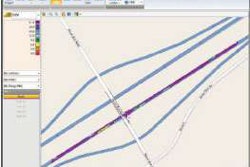HOT Time in the Old Town Tonight ( … and early morning and late afternoon)
Varying tolls to control congestion works. Sort of. Sometimes.
Congestion pricing cuts congestion. It’s true. But it’s not an entirely complete statement, because there are factors that mitigate the congestion-easing power. Road pricing or congestion pricing aims to motivate drivers to share rides, use transit, travel at less congested times, or pay to use tolled lanes. All projects in operation are either: High-Occupancy Toll (HOT) lanes, which charge solo drivers to use newly-constructed lanes or carpool lanes; or peak-period pricing projects, which charge a lower toll on already tolled roads, bridges and tunnels during off-peak periods. HOT lane tolls vary according to current demand; peak pricing projects create set fees for certain times of day.

“Hot lane projects, which aim to reduce congestion by decreasing travel time and increasing speed and the number of vehicles using the lane, have reduced congestion,” says the report. But there is a caveat. Some of those HOT lane projects also added new lanes, and GAO data does not distinguish the extent to which performance improvements were due to added lanes or pricing. High-Occupancy Vehicle road users, who usually pay no toll because they have, efficiently, loaded up their vehicle, can use HOT lanes without paying tolls.
Some HOT lanes have improved travel time and speed. The number of cars using HOT lanes has risen, but there are fewer people riding in those cars because of an increase in the proportion of toll-paying solo drivers and/or a decrease in carpools.
Peak-period pricing projects, however, did not appear to increase the number of people and vehicles using the targeted roads at peak times, although there has been some easing of congestion levels.
The GAO expresses concern about income equity in these anti-congestion practices. Are the costs of congestion pricing users incur proportional to their incomes, or are low-income drivers disproportionately affected? For example, low-income drivers may spend a greater proportion of their income to pay to travel at preferred times or incur greater costs in travel time by choosing alternate unpriced routes. High-income drivers who, economists generally believe, place a higher value on their time, may be more likely to pay the toll and benefit from a faster trip than low-income drivers.
For that matter there is uncertainty whether the practice of congestion practice hits any given group of people more unfairly than others. For example, the report worries about whether people from particular geographic areas are more negatively affected than others when traffic flow is manipulated. How equally are the costs and benefits associated with congestion pricing distributed within an affected metropolitan area? For example, if one corridor in a metropolitan area has congestion pricing and another does not, drivers in the tolled corridor may incur greater costs than drivers in the untolled corridor because of the tolls they pay or the increase in travel time they incur by choosing an alternate route.
Furthermore, drivers who choose to avoid the tolls and take an alternate route may contribute to congestion on the alternate route. Such diversion of traffic from tolled routes within a corridor can reduce the performance of the alternate untolled routes and negatively affect surrounding neighborhoods.
What happens to out-of-the-way neighborhoods that see more traffic as drivers steer clear of tolled roads, leaving behind the problems of increased traffic flow including pollution, safety, road deterioration and parking inadequacy?
What’s more, the GAO says equity problems may grow as pricing projects become more widespread.
New projects are already being built and a number of cities have networks of HOT lanes planned, significantly expanding the use of variable pricing across the country. “Equity concerns may become more acute where sponsors are using pricing not only to manage congestion, but also to raise revenue to build new projects,” says the report. “Raising revenue can be at odds with managing congestion (e.g., increasing passenger throughput) if higher tolls can produce more revenue from fewer paying vehicles.” It seems unlikely that using congestion pricing to raise revenue will remain a non-political football.
The GAO also concedes that concerns about the fairness of congestion pricing have “been a challenge to instituting these projects.”
One of the options to address equity issues that the GAO identifies is using some of the increased toll revenue to finance public transit service. This passing observation in the report may find itself center stage in the not-too-distant future. In crafting the reauthorization bill it brought to the floor last month, the House Transportation and Infrastructure Committee (or rather its Republican majority) stripped guaranteed federal money from public transit programs, essentially leaving them having to fight every other lobby in Washington for funds after 2016. Inevitably, some members of Congress will see tolls as a possible public transit subsidy source, if the need gets as urgent as transit supporters think it will.
“The changing character of congestion pricing and the new challenges it brings make improving the understanding of congestion pricing even more important.”
-GAO Report
Building new capacity to accommodate more vehicles is not an easy case to bring before Washington and win. And there are even researchers who argue more capacity will in fact only produce more congestion. And, of course, in some large cities, it is just not possible to add lanes; there is just no room.
According to the GAO, the first U.S. congestion pricing project opened in 1995, and 19 project sponsors now have 41 pricing projects in operation or under construction, and there are about 400 miles of priced highway lanes with tolls varying from 25 cents to $14.
In other words, congestion pricing in America is, as the GAO says, “in its infancy.” But, as the report concludes, “its popularity is growing. New projects under construction and in planning will not only increase the number of roadway miles that use congestion pricing, they will also change the character of pricing in the United States, as some will be operated privately and some will add congestion-priced tolls to previously non-tolled roadways. The changing character of congestion pricing and the new challenges it brings make improving the understanding of congestion pricing even more important.”
Economists argue that congestion pricing can be an economically efficient decongestant for busy roadways, with drivers who need or value a fast, predictable trip willing to pay for it, and those who do not prepared to stay on more crowded roads where they pay little or nothing.












